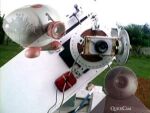SommaireIntroductionInstrumentation Imagery rules Reductions Precision Accuracy Conclusion |

© Florent Losse This article summarizes a communication to the Commission of the Double Stars of the Astronomical Society of France (Seminary September 2002, Dax Observatory) Published in Bull. de la commission des étoiles doubles de la SAF, n°40 The original text is a full evaluation of webcams in double stars measurements. Only the essential chapters are translated in english Full text in the french pages of this site |
INTRODUCTION
Long time interested by the visual observation of the double stars, I came naturally to try to measure them. From the chronometric method to various reticulated systems, then from the Hertzsprung-Duruy's grid to the filar micrometer, the experience was rich of teachings. While the grid comes quickly to its limits with amateur's instrument, the micrometer remained the absolute weapon. The results are worthy of the pain and energy but it's not so easy ! Tiredness due to the attention, permanent uncertainty of the moment you can read the indexes, quasi-necessity of a permanent installation of the telescope are as many elements that don't encourage the amateur to practice measurements. Remains the electronic imagery. By the end of 2000, a CCD camera fixed on a professional instrument is the privilege of some, and those who can make measurements with their own instrument are just as rare. Since several months I followed by curiosity the incredible progress of the webcams in planetary imagery. Their reputation of little sensitive instruments braked their use in the stellar domain. Owning an old computer, I however decided to acquire one of these cheap camera. Finally, in January 2001 I installed a webcam on the telescope telling me that in the absence of results on the double stars I could come back to the micrometer.INSTRUMENTATION
a) Telescope and Optical SettingsAll the evaluation course was led on the same instrument. A homemade 8" Newtonian telescope. Numerous combinations have been tested, from the primary focus to diverse optical trains involving one or two barlows lens. The longuest focal was about 6 meters.
b) Webcams
The webcams evaluated were Logitech Quickcam VC, Philips Vesta Pro et Toucam in commercial versions. Apart their intrinsic performances, all models were very near in terms of quality of measurements so the conclusion applies to all. The Vesta Pro was later used with modified electronics giving long exposure times (mod by Steve Chambers) and finally suited with a black and white sensor. This last configuration permits high performance on low brightness double stars.